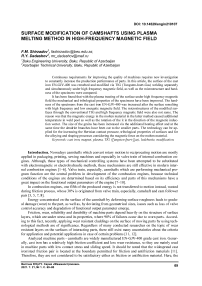Surface modification of camshafts using plasma melting method in high-frequency magnetic field
Бесплатный доступ
Continuous requirements for improving the quality of machines requires new investigation to constantly increase the production performance of parts. In this article, the surface of the cast iron EN-GJV-400 was remelted and modified via TIG (Tungsten-Inert-Gas) welding separately and simultaneously under high frequency magnetic field, as well as the microstructure and hardness of the specimens were compared. It has been found that with the plasma treating of the surface under high frequency magnetic field the mechanical and tribological properties of the specimens have been improved. The hardness of the specimens from the cast iron EN-GJV-400 was increased after the surface remelting with high frequency and low energetic magnetic field. The microstructures of the modified surfaces through the conventional TIG and high frequency magnetic field were also not same. The reason was that the magnetic energy in the molten material in the latter method caused additional temperature in weld pool as well as the rotation of the it in the direction of the magnetic induction vector. The size of the grains has been increased via the additional heating effect and at the same time the dendrite branches have been cut to the smaller parts. The technology can be applied for the increasing the Hertzian contact pressure, tribological properties of surfaces and for the alloying and shaping processes considering the magnetic force on the molten material.
Cast iron, magnet, plasma, tig (tungsten inert gas), ledeburite, modification
Короткий адрес: https://sciup.org/147233501
IDR: 147233501 | DOI: 10.14529/engin210107
Список литературы Surface modification of camshafts using plasma melting method in high-frequency magnetic field
- Ayanoglu, H.P. Experimentelle Erfassung des elastohydrodynamischen Kontaktes in Zahnradgetrieben und Nocken/Flachstößel-Paarungen: Diss. / H.P. Ayanoglu. – RWTH Aachen.
- Denger, D. Die elektrohydraulische Ventilsteuerung / D. Denger, K. Mischker // MTZ. – 2004. – Vol. 12.
- Халилов, Р.А. Системный анализ кулачковых механизмов автомобилей / Р.А. Халилов. – Баку, 2001. – 258 с.
- Левицкий, Н.И. Теория механизмов и машин / Н.И. Левицкий. – М.: Изд-во Машиностроение, 1965. – 365 с.
- Rothbart, H.A. Cam Design Handbook / H.A. Rothbart. – McGraw-Hill Professional, 2003 – 606 p.
- Nockenwelle, O. Ein neues elektromechanisches Ventiltriebssystem von Valeo / O. Nockenwelle. – Aachen, 1993. – 192 p.
- Vlotho, H.U. Zur Reibung von Nockentrieben mit Flachstößeln / H.U. Vlotho // Konstruktionstechnik .Ser. “Maschinenelemente”. – 1985. – No. 129. – 134 p.
- Holland, J. Stößel-Rotation im Nocken-Flachstößel-System / J. Holland, A. Schmidt // Technologie Schmierungstechnik. – 1993. – Vol. 1. – P. 10–15.
- Spiegel, K. Beiträge zur Elastohydrodynamik bei Nocken-Stößel-Paarungen / K. Spiegel. – Technische Universität Clausthal, 1982. – 196 p.
- Meusburger, P. Leichtbau im Motorenbau mit gebauten Nockenwellen / P. Meusburger // MTZ. – 2006. – Vol. 03. – P. 174–179.
- Shirzadov, F. Erhöhung der Verschleißbeständigkeit von Ventiltrieb-Werkstoffpaarungen mittels unterschiedlicher Randschichtmodifikationen: Dissertation / F. Shirzadov. – Berlin, 2012. – 178 p.
- Musayev, Y.B. Verbesserung der tribologishen Eigenschaften von Stahl/Stahl- Gleitpaarungen für Präzisionsbauteile durch Diffusionsmetallisieren im Vakuum. Dissertation / Y.B. Musayev. – Nürnberg: Universität Erlangen, 2001. – 180 p.
- Kuhn, M. Diamantähnliche Kohlenstoff-Schichten für tribologische Anwendungen / M. Kuhn, C. Hammerl // Deutschland: Oberflaeschentechnik. – 2001. – Band 61. – P. 121–127.
- Tribologische Optimierung von Ventiltrieben durch Beschichtungstechnik / J. Brand, C. Beckmann, T. Münnich, T. Filfil // Tribologie, Schmierungstechnik. – 2001. – Vol. 48, No. 1. – P. 22–26.
- Heck, K. Einfluss der Prozessführung beim Umschmelzhärten auf die Randschichteigenschaften von Nockenwellen aus ledeburitischem Gusseisen: Diss. für Dr.-Ing. / K. Heck. – München, 1983. – 173 p.
- Ширзадов, Ф.М. Наплавка поверхности под действием магнитного поля / Ф.М. Ширзадов, А.И. Садыхов, Л.А. Гасимова // Вестник машиностроения. – 2015. – T. 3. – С. 50–52.
- Willermet, P.A. The composition of lubricant – derived surface layers formed in a lubricated cam/tappet contact II. Effects of adding overbased detergent and dispersant to a simple ZDTP solution / P.A. Willermet // Tribology International. – 1995. – Vol. 28 (3). – P. 163–165.
- Stipek, T. Neue Gesichtspunkte bei der Auslegung von Nocken fuer Dieseleinspritzpumpen / T. Stipek // MTZ. – 1980. – Vol. 41 (1) – P. 13–18.
- Wetzig, A. Induction assisted laser remelting of gray cast iron with different chromium contents / A. Wetzig, D. Lepski, B. Brenner // Lasers in Engineering. – 2000. – Band 10. – P. 19–35.
- Holland, J. Untersuchung des Temperaturverhaltenes von Nockentrieben / J. Holland, Ch. Degenhardt // MTZ. – 1988. – Vol. 49 (10). – P. 391–395.


